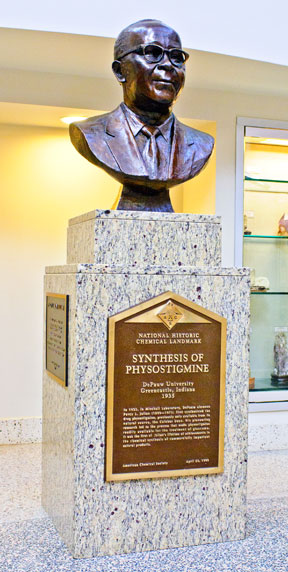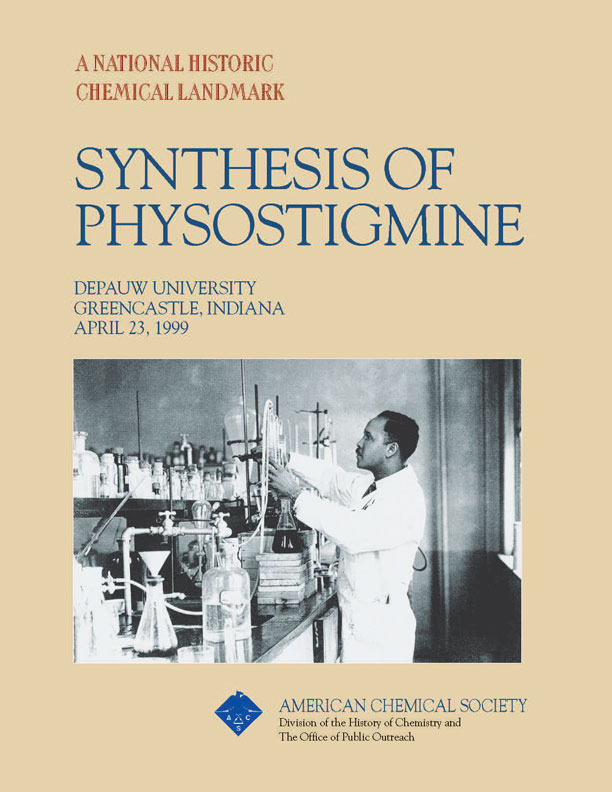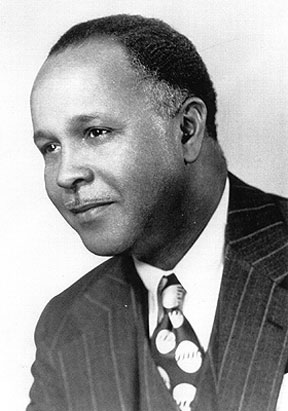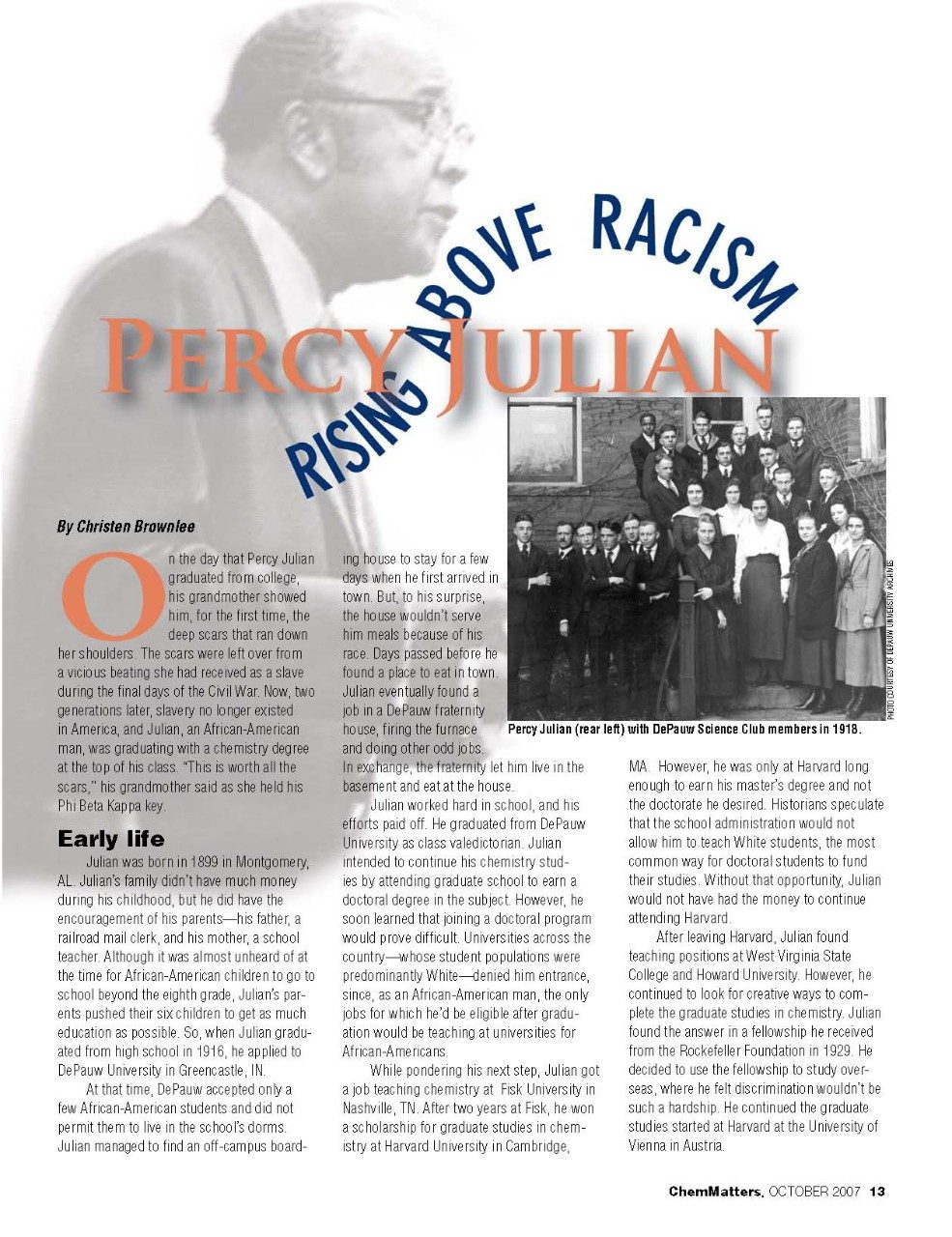Percy L. Julian and the Synthesis of Physostigmine
National Historic Chemical Landmark
Dedicated April 23, 1999 at DePauw University in Greencastle, Indiana
In 1935, in Minshall Laboratory, DePauw alumnus Percy L. Julian (1899-1975) first synthesized the drug physostigmine, previously only available from its natural source, the Calabar bean. His pioneering research led to the process that made physostigmine readily available for the treatment of glaucoma. It was the first of Julian’s lifetime of achievements in the chemical synthesis of commercially important natural products.
Contents
Percy L. Julian and Chemistry at DePauw University
The early 1930s was a time of great chemical research productivity at DePauw. It was in this decade that William M. Blanchard, Dean of the University, hired Percy Julian as a research fellow. Blanchard, who also served as head of the chemistry department, had been Julian's mentor during his undergraduate years at DePauw. Julian had received a Ph.D. degree in Vienna in 1931 and was in need of a position in which he could continue his research career. The DePauw chemistry program he joined in 1933 had roots that extended back to 1839 when the university was Asbury College and chemistry was offered as a natural science course taught by the president, Matthew Simpson. Chemistry became a distinct department in 1881 under the direction of Phillip S. Baker. The department prospered and a chemistry major was established in 1896. Percy Julian graduated from this program in 1920.
As a research fellow from 1932 to 1935, Julian, working with his colleague from Vienna, Josef Pikl, and several DePauw students, produced a phenomenal number of high-quality research papers. One such paper appeared in the April 1935 issue of the Journal of the American Chemical Society. This paper, entitled "Studies in the Indole Series V. The Complete Synthesis of Physostigmine (Eserine)," which explained how Julian synthesized physostigmine, is undoubtedly the most significant chemical research publication to come from DePauw. The student and faculty collaborative approach, promoted by Julian, has continued to the present, and today most of the research at DePauw is done in collaboration with students.
After the grant funding Julian's position expired, Blanchard wanted to appoint Julian to the teaching staff. Despite Julian's achievements, the Board of Trustees did not allow it. Julian left DePauw to pursue a distinguished career in industry.
In 1967, Julian was appointed to the DePauw University Board of Trustees. Also that year, planning began for a new science building, which would replace the 65-year-old Minshall Laboratory, and construction commenced in 1968. The Science and Mathematics Center was dedicated in September 1972, with Percy Julian giving the dedication address, "Science and the Good Life of Man." Following Julian's death, DePauw University named the Percy L. Julian Science and Mathematics Center in his honor.
Percy Julian's Science
When Percy Julian returned to the DePauw University campus in 1932, he embarked on the project that would forever secure his reputation as a world-class researcher the first total synthesis of the anti-glaucoma drug physostigmine, an alkaloid found in the Calabar bean. Glaucoma, a disorder in which the pressure in the eyeball increases when the aqueous humor does not drain normally, can cause damage to the optic nerve and a loss of vision. Physostigmine promotes drainage of this fluid by easing the constriction of outflow channels. 65 years later, Julian's achievement still remains important as derivatives and optically pure forms of physostigmine continue to show therapeutic promise for the treatment of Alzheimer's disease and for combating the effects of chemical weapons.
Starting from phenacetin, Julian and Josef Pikl, who was working as an assistant in chemistry, assembled physostigmine in 11 synthetic steps. The project, which took three years to complete, was reported in a series of papers in the Journal of the American Chemical Society. During the project, while the two chemists were working toward the synthesis of d,l-eserethole (a key intermediate compound two steps removed from physostigmine), a group of chemists, also working to synthesize physostigmine, under the direction of Sir Robert Robinson at Oxford University in England, reported their synthesis of d,l-eserethole. Unlike today, when chemists can rely on modern analytical methods such as nuclear magnetic resonance spectroscopy, mass spectrometry, and X-ray crystallography to determine unequivocally the composition and structure of a compound, chemists in the 1930s relied on simpler, indirect, physicochemical methods for their analysis. As it happened in the case of d,l-eserethole, the physicochemical parameters of Robinson's d,l-eserethole were not in agreement with those of Julian and Pikl. Firm in his conviction that his synthetic strategy was sound, Julian risked his yet-unproven reputation and boldly wrote in the fourth paper in the series that the work of Robinson was in error.
Subsequently, in the much celebrated fifth paper in the series, "Studies in the Indole Series V. The Complete Synthesis of Physostigmine (Eserine)," Julian summarized his and Pikl's work on the most challenging total synthesis project of its time with the following:
"Physostigmine, the principal alkaloid of the Calabar bean, and long used as a drug, has, since its isolation by Jobst and Hesse 70 years ago, been the subject of numerous investigations. The determination of its constitution was rendered particularly difficult since its peculiar chemical structure found no analog in other plant products of known composition.
“Shortly after promising experiments in the direction of (its synthesis) were underway (in our laboratory) the work had to be interrupted and could only be resumed recently. In the meantime, the first of a series of ten papers dealing with the synthesis of physostigmine, by Robinson and his collaborators, appeared and seemingly proved convincingly that the (course) suggested in our formulas could not be realized in practice. Our experiments, nevertheless, were continued and ... led to the successful synthesis of d,l-eserethole.
“To our surprise, our d,l-eserethole exhibited entirely different properties than those of a compound synthesized by Robinson and his coworkers and called d,l-eserethole. Likewise were all derivatives different. Inasmuch as our (optically) inactive material subjected to characteristic reactions of eserethole of natural origin yielded perfectly analogous results, we expressed the belief that our product was the real d,l-eserethole and that of the English chemists must be assigned another constitution.
“This is now proved conclusively by synthesis of l-eserethole, identical with the product of natural origin.”
Following the total synthesis of physostigmine and the separation of physostigmine into its optical isomers, Julian was to make another discovery at DePauw that not only would enhance his stature as a chemist but also greatly improve the lives of many. It was in the course of isolating geneserin, a companion alkaloid of physostigmine from the Calabar bean, that Julian discovered small crystals of the hydrate of stigmasterol in the acid-washed oil extracted from the beans. Molecules such as stigmasterol possess a central structural unit composed of 17 carbon atoms arranged into four fused rings that is also found in many biologically significant compounds such as cholesterol and the sex hormones, estradiol and testosterone. More generally known as steroids, these compounds cover a broad range of form and function and in many cases are of great value as therapeutic agents.
It was four years after this serendipitous discovery of the stigmasterol crystals that Percy Julian, then the director of research in the Soya Products Division of the Glidden Co., was summoned to a 100,000 gallon soybean oil storage container. Water seeping into the oil had resulted in the formation of a white solid material that had collected at the bottom of the tank. Remembering his DePauw experience, Julian realized that the extremely small amounts of sterols contained in soybean oil had been concentrated and isolated in the white solid. Subsequent modification of this "accidental procedure" led to the daily production of 100 pounds of mixed soya sterols worth more than $3.6 million annually. These sterols were then easily converted using methods and equipment designed by Julian to produce commercial quantities of a variety of sex hormones, including progesterone, all at a greatly reduced cost to the public but still with a healthy profit for Glidden.
Later in his career at Glidden and at his own research institute, the Julian Laboratories, Percy Julian continued to make important contributions to the field of medicinal chemistry. His 1948 synthesis of Reichstein's Substance S is still the most widely used route to the production of hydrocortisone and its derivatives, which are used in the treatment of rheumatoid arthritis. He developed efficient syntheses for whole families of steroids including 4,5-epoxy steroids, 16,17-epoxy steroids, 21- iodo steroids, 17-hydroxy steroids, 4-halo steroids, and numerous steroids containing the diosphenol structure. In later years, he worked on the synthesis of the yohimbine alkaloids and in uncovering the metabolism of tryptophan, one of the nine amino acids essential for healthy living.
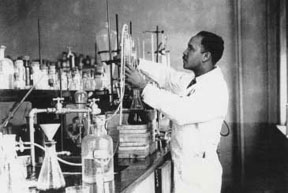
Biography of Percy Lavon Julian
In a lifetime of continual striving, Percy L. Julian (1899-1975) succeeded against the prejudices and discrimination of his time to become a pathbreaking synthetic chemist, a successful industrial research director, and a wealthy businessman.
Julian was born in Montgomery, Ala., on April 11, 1899, the son of a railway clerk and the grandson of slaves. From the beginning, he did well in school, but there was no public high school for African Americans in Montgomery. Julian graduated from an all-Black normal school inadequately prepared for college. Even so, in the fall of 1916, at the age of 17, he was accepted as a sub-freshman at DePauw. This meant that in addition to his regular college courses he took classes at a nearby high school. He also had to work in order to pay his college expenses. Nevertheless, he excelled.
Julian was elected to Phi Beta Kappa and graduated with a B.A. degree in 1920 as valedictorian of his class. His chosen path of chemistry would prove to be a rocky one. With no encouragement to continue his education, based on the lack of future job opportunities, Julian found a position as instructor in chemistry at Fisk University, in Nashville, TN.
After two years at Fisk, Julian won an Austin Fellowship to Harvard and received his M.A. degree in 1923. Again, he faced disappointment when no job offer was forthcoming. In succeeding years, he served on the staff of predominantly Black institutions — first at West Virginia State College, and in 1928, as head of the department of chemistry at Howard University, Washington, D.C. In 1929, Julian received a Rockefeller Foundation grant and the chance to earn his doctorate in chemistry. He elected to study natural products chemistry with Ernst Späth at the University of Vienna. He received his Ph.D. in 1931 and returned to Howard, accompanied by his friend, Josef Pikl. After two years there, internal politics forced them to leave.
In 1933, through the efforts of his former professor William Blanchard, Julian returned to DePauw University as a research fellow. He directed research projects for senior and graduate students. It was here in Minshall Laboratory in 1935, in collaboration with Pikl, that he completed the research that would result in the total synthesis of physostigmine. This work established Julian’s reputation as a world-renowned chemist at the age of 36.
Despite his accomplishments as a recognized and published researcher, Percy Julian was denied a faculty position at DePauw. Frustrated in his efforts to gain an academic post, Julian turned to industry. One research job fell through because of a town law forbidding “housing of a Negro overnight.” Then, in 1936, a door opened when Julian was offered a position as director of research for soya products for Glidden in Chicago. Over the next 18 years, the results of his soybean protein research produced numerous patents and successful products for Glidden, among them a paper coating and a fire-retardant foam used widely in WWII to extinguish gasoline fires. His biomedical research made it possible to produce large quantities of synthetic progesterone and hydrocortisone at low cost.
In 1953, he established Julian Laboratories, a successful enterprise that he sold for more than $2 million in 1961. He later formed Julian Research Institute, a nonprofit research organization. Among his many lifetime honors was election, in 1973, to the National Academy of Sciences. He was also widely recognized as a steadfast advocate for human rights. Julian continued his private research studies and served as a consultant to major pharmaceutical companies until his death on April 19, 1975.
Further Reading
- Percy Lavon Julian ’20 (DePauw University)
- The Life and Science of Percy Julian (Chemical Heritage Foundation)
Landmark Designation and Acknowledgments
Landmark Designation
A plaque marking the event was presented to DePauw University on April 23, 1999, during the university’s celebration of the centennial anniversary of Percy Julian’s birth. The inscription reads:
In 1935, in Minshall Laboratory, DePauw alumnus Percy L. Julian (1899-1975) first synthesized the drug physostigmine, previously only available from its natural source, the Calabar bean. His pioneering research led to the process that made physostigmine readily available for the treatment of glaucoma. It was the first of Julian’s lifetime of achievements in the chemical synthesis of commercially important natural products.
Acknowledgments
Adapted for the internet from “Synthesis of Physostigmine,” produced by the National Historic Chemical Landmarks program of the American Chemical Society in 1999.
Back to National Historic Chemical Landmarks Main Page.
Learn more: About the Landmarks Program.
Take action: Nominate a Landmark and Contact the NHCL Coordinator.
